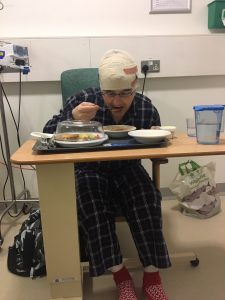Andy’s story:
For Andy Tudor, 2017 began in a whirlwind. Coming home from work feeling poorly on 11 Jan, it was only 7 weeks later that he had returned home from hospital following neurosurgery to remove a large meningioma.
Determined to raise awareness around the symptoms, experience of and recovery from a brain tumour – and to tell the story with his own humorous twist – Andy has written up his experiences.
He describes 2017, the year of his diagnosis and treatment for a large meningioma, as “a year of firsts”. His first stay in hospital, operation, and the first time he really thought about his own mortality.
“It’s also been the first time I’ve been able to stop and fully appreciate the true depth of love, support, warmth from many family and friends. It has been a truly humbling experience”.
Warning signs

Andy had a few symptoms from around 6 months before his diagnosis. These included flashing lights in his peripheral vision, occasionally taking the wrong turns when walking or driving, and a limp. Easy to overlook with his busy lifestyle, Andy assumed these to be to do with getting older, and trips to the GP for isolated incidents didn’t reveal any underlying issues.
However, 24 hours before being taken to hospital, Andy’s symptoms suddenly became far more intense and severe. Loss of control of his left arm and leg, intense headaches and repeated vomiting left Andy in desperate need of the hospital – and so he went by ambulance…
It’s ‘a big one’
After a few days in hospital, it was clear that Andy had a large meningioma – in the doctor’s words, “a big one”. The symptoms he had experienced were a result of the swelling caused around the edge of the mass as it pushed on his brain. The danger lay in his brain being herniated (pushed down the spine) as it had nowhere to go from the swelling. There were signs that this was beginning to happen, so an action plan was put together. Fortunately, the steroids were reducing the swelling, so during this time of stability a plan could be formulated.
6 weeks on steroids
Andy wasn’t sleeping, apart from the occasional 15 minute snooze, thanks to his steroids. Nights were spent watching TV, doing puzzles and feeding his insatiable hunger!
“I’m spending my time in a cocoon of tv news/sport & weather, papers, magazines, Sudoku’s, grazing, and napping. All helping to keep me nice and calm. And my first benefit of all this – we’ve now also got BT Sport! NBA basketball tonight and Liverpool v Swans on the weekend plus baseball, etc. Good job I’m on steroids to keep me awake for all this sport!”
When he finally received the date of his surgery, Andy felt a mixture of emotions – the gut reaction being relief. Having never been in hospital, let alone being put under general anaesthetic, Andy thought that he would be terrified before the operation. The fact that it was a routine procedure, with high survival rates, helped him to stay calm. He found that not asking what would happen in detail (and staying away from Google about this!) had helped him to worry less.
The op
Within 2 hours of his surgery, Andy was texting people to say he was OK! Always keeping his sense of humour, Andy’s first message that he sent to his kids was in Chinese, as they’d had a running joke that he might wake up from the op able to speak mandarin!
I then sent many family and friends the same message: “The surgery was successful! They removed it all in a 6 hour operation. Removing my mahussive grin may take a little longer!”
Andy’s surgery had gone well, but there had been some bleeding during the operation. He had also acquired shingles, but despite this he was able to return home 2 days after his surgery.

What Andy’s diary captures next is how the aftermath of surgery, when you leave hospital and return to life as you knew it, is often the most uncertain and difficult time.
Recovery from surgery, shingles, bruising and a fluid filled scar on his head – these things took longer. Andy happily welcomed sleep back into his life as he was weaned off his steroids, but the next few months were a period of ups and downs.
6 weeks post-surgery, despite being told by loved ones he “looks fantastic” and despite being back waking and talking like normal, Andy was feeling low and easily drained, which was confusing for him and difficult to understand. He had expected to be jumping for joy after his successful surgery!
“It does take time to heal from the shock as well. Let alone from the operation itself. Family and friends just see us smiling and up and about like we used to be – they don’t see the internal struggle. Takes time to heal mentally as well physically.”
Fatigue was something that really affected him following his surgery. Learning to manage your fatigue takes time – we have a resource that will help (download it here).
After four months, Andy was able to begin gradually returning to his job in software management. He was part-time at first, increasing his hours from two 4-hour days a week back to full time 9 months post op.
There are all sorts of reasons why returning to work after a brain tumour can be difficult. Check out our Returning to Work Know How for advice on how to do this at a pace that’s right for you.
And now?

Andy has now been back working full time 18 months, and has been enjoying his ‘normal life’, with his second annual scan recently coming back all clear.
“I realise there are many who don’t have such a positive outcome as I have, but I thought I’d share my story to hopefully show that positive outcomes are possible and common”
Andy has written up his story here in more detail (aptly named Tumour Humour) for those who would like to read it.








